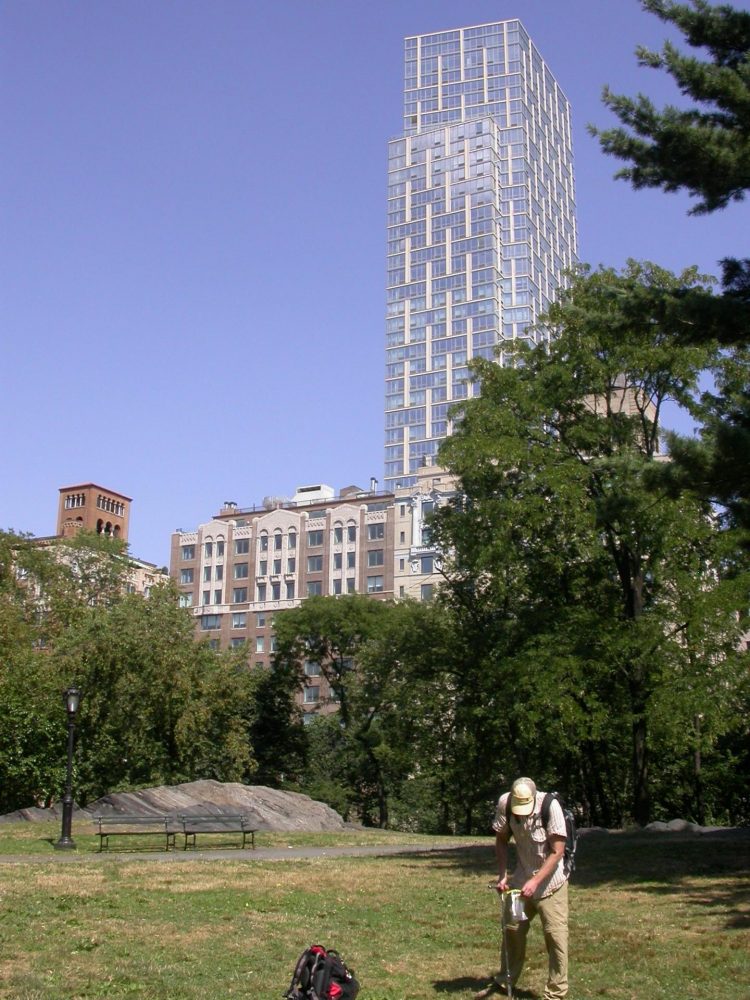Microbes in Central Park soil: If they can make it there, they can make it anywhere

A member of the research team takes a soil sample in Central Park. Credit: Noah Fierer
The research team analyzed 596 soil samples collected from across Central Park's 843 acres and discovered a stunning diversity of below-ground life, most of which had never been documented before.
Only 8.5 percent to 16.2 percent of the organisms discovered in the park soils, depending on their type, had been previously entered into existing databases that describe microbial life, according to the study results published today in the journal Proceedings of the Royal Society B.
“We found thousands of different organisms, and it was shocking how few had ever been described,” said Noah Fierer, an associate professor of ecology and evolutionary biology at CU-Boulder and corresponding author of the study. “Not only do they not have a name, but we don't know anything about them. We don't know what sort of conditions they like to live under or what role they may play in soil habitat and soil fertility.”
The study was led by Kelly Ramirez, a postdoctoral researcher at Colorado State University, now at the Netherlands Institute of Ecology in The Netherlands. Ramirez did her research in the Soil Biodiversity and Ecosystem Functioning Lab at CSU, headed by biology Professor Diana Wall, director of the School of Global Environmental Sustainability and a corresponding author on the study.
Other co-authors from CSU are soil science Professor Eugene Kelly and biology doctoral student Ashley Shaw. Other CU-Boulder co-authors are doctoral students Jonathan Leff and Christopher Steebock, and postdoctoral researcher Albert Barberan.
Wall, who will be speaking at the induction ceremony at the American Academy of Arts and Sciences later this month, said Ramirez's work uncovered another melting pot of diversity in New York City — within the soil of Central Park.
“The soil microbes in Central Park benefit us, benefit soil health, and are linked tightly to the beauty of the trees and other plants we see,” she said. “The nation's food, cities, clean air and water and economy are all dependent on healthy, fertile soils and that motivates us to understand this fascinating hidden life beneath our feet.”
The scientists also compared the below-ground biodiversity in Central Park to 52 soil samples taken from locations spanning the globe, from Alaska to Antarctica. The team was surprised to find that the breadth of biodiversity beneath Central Park is similar to the biodiversity found across the world, from the frozen Artic tundra to hot deserts and nearly everything in between. The only area that did not have soil microbial communities that overlapped with the samples taken from Central Park was Antarctica, where Wall has done extensive research.
“If you want to find unique diversity and if you want to find a wide range of different below-ground organisms, you don't have to travel around the world,” said Fierer, who is also a fellow at the Cooperative Institute for Research in Environmental Sciences. “You can walk across Central Park.”
The types of plants and animals that are able to live in a particular biome, like the desert, are largely determined by the climate. But microbes appear to be more concerned about the environment in the soil, such as the acidity and the carbon availability, than how hot or dry the climate is. This allows diverse microbial communities to thrive wherever the soil conditions are equally diverse.
“No one would ever expect to find an overlap in the types of trees we see in Central Park and the type of trees we see in a tropical forest,” Fierer said. “But that doesn't seem to be true for the microbes living in the soil. We found all these community types just within Central Park. Below-ground biodiversity doesn't follow the same rules as the plants and animals living above ground.”
Co-authors of the study from other institutions are Scott Bates of the University of Minnesota; Jason Betley of Illumina UK; and Thomas Crowther, Emily Oldfield, and Mark Bradford of Yale University. The study was partially funded by the Winslow Foundation.
The full text of the paper can be found on the Royal Society website under Journal News, https://royalsociety.org/news/list/?type=journal .
Contact:
Kate Jeracki, Colorado State University external relations, 970-491-2658
Kate.jeracki@colostate.edu
OR
Laura Snider, CU-Boulder media relations, 303-735-0528
Laura.Snider@colorado.edu
Media Contact
All latest news from the category: Life Sciences and Chemistry
Articles and reports from the Life Sciences and chemistry area deal with applied and basic research into modern biology, chemistry and human medicine.
Valuable information can be found on a range of life sciences fields including bacteriology, biochemistry, bionics, bioinformatics, biophysics, biotechnology, genetics, geobotany, human biology, marine biology, microbiology, molecular biology, cellular biology, zoology, bioinorganic chemistry, microchemistry and environmental chemistry.
Newest articles

Largest magnetic anisotropy of a molecule measured at BESSY II
At the Berlin synchrotron radiation source BESSY II, the largest magnetic anisotropy of a single molecule ever measured experimentally has been determined. The larger this anisotropy is, the better a…

Breaking boundaries: Researchers isolate quantum coherence in classical light systems
LSU quantum researchers uncover hidden quantum behaviors within classical light, which could make quantum technologies robust. Understanding the boundary between classical and quantum physics has long been a central question…

MRI-first strategy for prostate cancer detection proves to be safe
Active monitoring is a sufficiently safe option when prostate MRI findings are negative. There are several strategies for the early detection of prostate cancer. The first step is often a…



